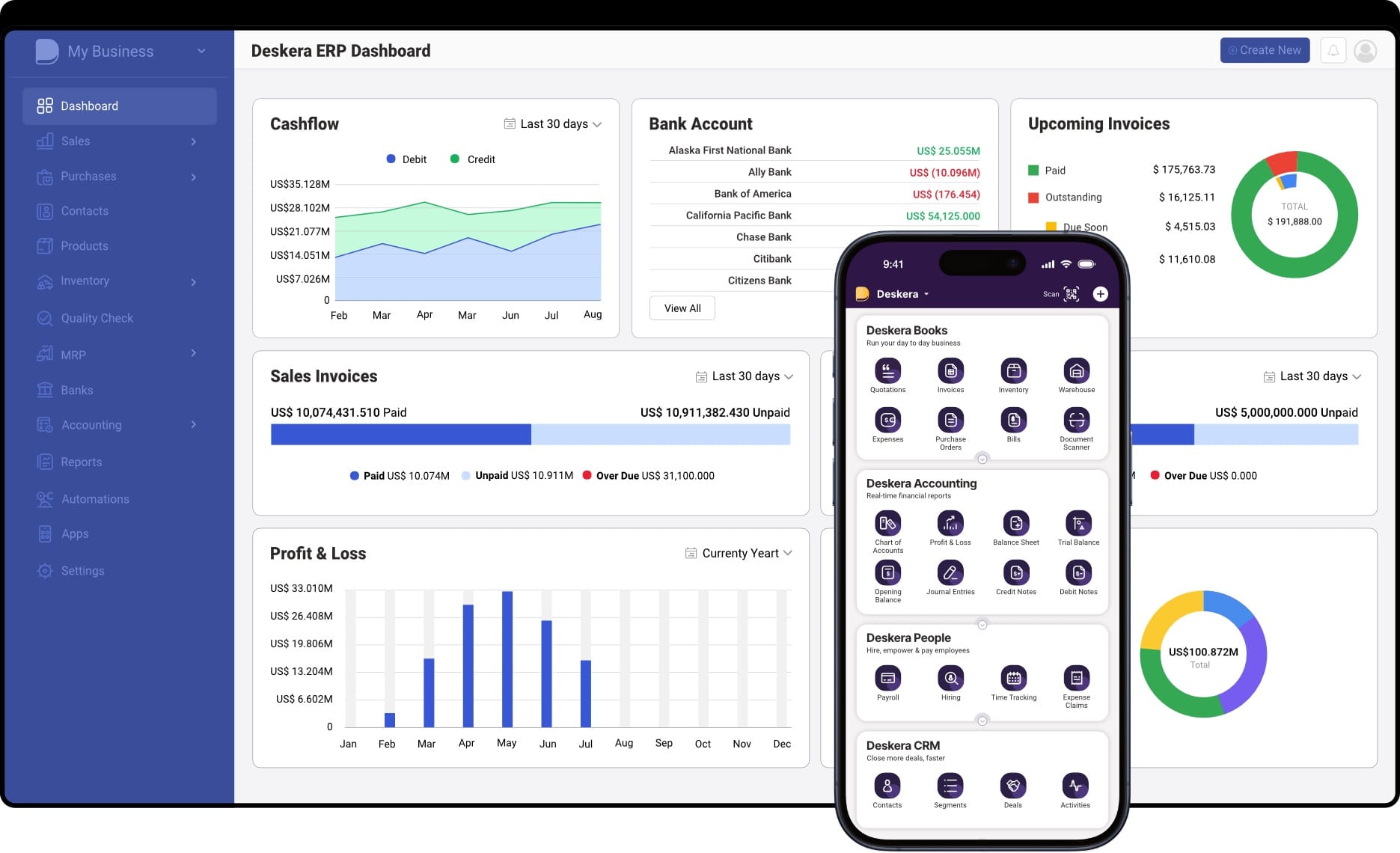Have you ever wondered why some businesses grow their revenue and profit margins even in a competitive or uncertain market, while others struggle to stay afloat? The answer often lies in how effectively they use data, processes, and technology to make faster, smarter, and more profitable decisions. In today’s landscape, ERP systems are no longer just accounting or inventory tools—they are profitability engines that help businesses unlock new revenue opportunities and safeguard margins at every step.
As markets become more dynamic and customer expectations rise, relying on manual systems or scattered software creates bottlenecks, revenue leakage, and inaccurate financial insights. ERP systems solve these challenges by integrating your operations—from sales and production to finance and supply chain—into a single source of truth. This unified data allows businesses to reduce costs, improve demand forecasting, boost sales, and make decisions that consistently elevate their top and bottom lines.
Revenue and profit margins improve when businesses can anticipate demand, fulfill orders on time, offer accurate pricing, and eliminate inefficiencies. ERP makes all of this possible by revealing hidden cost drivers, providing real-time visibility, and enabling automation that directly strengthens operational and financial performance. When used strategically, ERP becomes more than a system—it becomes a driver of sustainable, long-term growth.
Deskera ERP exemplifies this modern approach. With AI-powered features like David, advanced demand forecasting, real-time inventory visibility, automated MRP, mobile accessibility, and robust financial reporting, Deskera empowers businesses to make profitable decisions faster. Its ecosystem is designed to help companies optimize their operations, reduce costs, enhance customer experience, and ultimately boost revenue and profit margins with confidence and precision.
The Importance of Revenue and Profit Margins for Businesses
A company’s ability to grow and stay competitive depends on how effectively it generates revenue and protects its profit margins. While revenue reflects how well a business attracts customers and sells its products or services, profit margins reveal how efficiently it operates.
Together, they form the financial foundation that determines long-term sustainability, expansion potential, and competitive strength. Understanding both—and improving them strategically—is crucial for business leaders today.
1. Revenue Drives Business Growth and Market Expansion
Higher revenue enables businesses to invest in new markets, improve products, expand their workforce, and increase production capacity. Strong revenue also signals customer demand and market relevance, helping businesses build confidence among investors and partners.
2. Profit Margins Reflect Operational Efficiency
Profit margins show how effectively a company converts revenue into actual profit. High margins indicate streamlined operations, controlled costs, and optimized pricing strategies. Low margins, on the other hand, highlight inefficiencies, leakages, or cost challenges that need urgent attention.
3. Healthy Margins Improve Cash Flow and Financial Stability
A company with strong margins enjoys better cash reserves, which improves its ability to manage monthly expenses, handle unforeseen challenges, and invest strategically. Healthy cash flow also reduces dependence on external funding, making the business more resilient.
4. Strong Revenue and Margins Enable Long-Term Sustainability
With stable revenue and strong margins, businesses can plan for the future with confidence. This includes expanding product lines, adopting new technologies, pursuing partnerships, and maintaining competitiveness even during economic shifts.
How ERP Systems Directly Influence Revenue and Profit Margins
ERP systems play a far more strategic role today than simply managing operations—they actively shape how businesses earn revenue and protect their profit margins.
By unifying data, automating workflows, and providing real-time visibility, ERPs help companies make decisions that impact both top-line growth and bottom-line efficiency. The result is a more resilient, agile, and profitable business model.
1. ERP Eliminates Operational Inefficiencies That Reduce Margins
ERP systems streamline fragmented processes by integrating sales, inventory, finance, procurement, and production into one unified platform. This reduces manual errors, duplicate work, delays, and overhead costs—directly improving gross and net margins. When waste decreases, profit margins naturally rise.
2. ERP Provides Real-Time Visibility for Faster, Smarter Decisions
Businesses gain a complete snapshot of orders, cash flow, inventory levels, supplier performance, and costing in real time. This visibility helps leaders act quickly on market changes, adjust pricing, manage demand fluctuations, and prioritize profitable orders—boosting both revenue and margin quality.
3. ERP Improves Inventory Accuracy and Product Availability
Accurate inventory data reduces stockouts and overstocking. More availability means more fulfilled orders and fewer missed sales opportunities—improving revenue. At the same time, optimized stock levels reduce holding costs and wastage, strengthening margins.
4. ERP Strengthens Cash Flow and Financial Control
With automated billing, accurate costing, expense tracking, and real-time financial reporting, ERP provides a clearer view of profitability drivers. Businesses can quickly spot revenue leakages, underpriced products, or high-cost processes—and fix them before margins take a hit.
5. ERP Enhances Customer Experience and Revenue Growth
Faster order processing, accurate delivery timelines, and personalized service all come from integrated data. Happier customers place more orders, stay loyal longer, and contribute to higher lifetime value—driving sustained revenue growth.
6. ERP Supports Better Pricing and Product Mix Decisions
ERPs help businesses analyze which products, SKUs, or customer segments are truly profitable. This empowers data-driven decisions around pricing, discounting, product bundling, and discontinuing low-margin offerings—leading to more revenue and better margin performance.
Top 10 ERP Strategies to Boost Revenue and Profit Margins
ERP systems have evolved from simple process-management tools into strategic engines for business growth. When used effectively, they not only streamline operations but also unlock measurable improvements in revenue, cost control, customer satisfaction, and overall profitability.
Below are powerful ERP-driven strategies every business can apply to strengthen both top-line and bottom-line performance.
1. Improve Demand Forecasting Accuracy
Accurate forecasting is one of the most direct ways ERP systems help increase revenue and margins. With AI/ML-powered algorithms, ERPs analyze past sales patterns, market trends, and seasonal fluctuations to predict demand with precision. This reduces stockouts, prevents excess inventory, and eliminates costly rush orders. As a result, businesses fulfill more orders on time, increase sales, and enhance gross margins by keeping inventory aligned with actual customer demand.
Key Benefits:
- Uses ERP + AI/ML models for accurate demand prediction
- Reduces stockouts, lost sales, and emergency procurement costs
- Aligns inventory with demand to improve revenue and margins
- Increases forecast reliability for production and purchasing decisions
2. Optimize Pricing and Order Profitability
ERP systems give businesses real-time visibility into product costs, overheads, and profitability, enabling smarter pricing strategies. Organizations can implement dynamic pricing, adjust quotes accurately, and ensure every order meets margin targets.
This prevents underpricing, improves quote-to-cash cycles, and maximizes revenue per transaction. With ERP insights, businesses can also evaluate customer-specific margins to prioritize high-value accounts.
Key Benefits:
- Real-time costing helps maintain target margins
- Enables dynamic pricing based on demand and costs
- Prevents underpriced orders and revenue leakage
- Improves quote accuracy for profitable sales
3. Boost Sales Through Better Inventory Availability
When customers can rely on product availability, sales naturally increase. ERP systems track inventory levels across warehouses, locations, and channels, ensuring stock accuracy at all times.
This reduces stockouts, improves fill rates, and supports faster order fulfillment. The result: higher customer satisfaction, repeat orders, and greater revenue. By eliminating emergency procurement and expediting costs, ERP systems also improve overall profit margins.
Key Benefits:
- Reduces stockouts and improves fill rate
- Ensures real-time inventory visibility across locations
- Enables faster order fulfillment and higher sales
- Minimizes costly emergency procurement
4. Streamline Operations to Reduce Hidden Costs
Operational inefficiencies—such as process delays, manual errors, and unnecessary approvals—quietly erode profit margins. ERP systems identify and eliminate these issues through automation, workflow optimization, and increased transparency.
This leads to lower labor costs, reduced rework, and faster processing across departments. With smoother operations, businesses reduce overhead expenses and improve net margins without increasing revenue.
Key Benefits:
- Identifies bottlenecks and process inefficiencies
- Automates repetitive tasks to reduce labor time
- Minimizes errors and rework costs
- Improves operational throughput and cost efficiency
5. Strengthen Supply Chain Efficiency
A strong supply chain is essential for protecting margins and increasing revenue. ERP systems offer deeper visibility into supplier performance, lead times, and purchase costs.
Businesses can negotiate better terms, plan procurement earlier, and avoid last-minute purchases. Improved planning enhances contribution margin, reduces freight costs, and stabilizes cash flow—making the overall business more resilient and profitable.
Key Benefits:
- Monitors vendor performance and lead time accuracy
- Improves procurement planning and cost control
- Reduces supply chain disruptions and purchase overruns
- Enhances cash flow through optimized scheduling
6. Improve Customer Experience and Lifetime Value
ERP systems integrate CRM data to deliver personalized experiences that strengthen customer loyalty. With complete visibility into order history, preferences, and interactions, businesses can tailor offers, upsell effectively, and resolve issues faster. Improved service quality drives repeat purchases, increases customer lifetime value (LTV), and results in more stable, recurring revenue.
Key Benefits:
- Uses ERP + CRM insights for personalized engagement
- Enables faster response times and better service
- Supports upselling and cross-selling opportunities
- Improves customer loyalty and recurring revenue
7. Enhance Financial Visibility for Better Decision-Making
ERP systems unify financial data so leaders can analyze profitability in real time. Businesses can identify loss-making products, underperforming channels, and high-cost operations instantly.
With granular insights, companies can adjust pricing, discontinue low-margin items, or shift focus to high-value customer segments. This data-driven approach strengthens both revenue quality and profit margins.
Key Benefits:
- Provides real-time financial and profitability insights
- Identifies high- and low-margin products and customers
- Enables strategic pricing and cost-control decisions
- Improves financial planning and forecasting accuracy
8. Increase Production Efficiency (For Manufacturers)
For manufacturing companies, ERP-driven MRP improves production scheduling, capacity planning, and material allocation. This reduces downtime, cuts material waste, and increases throughput.
When businesses produce more units at lower cost, they improve both revenue potential and profit margins without expanding resources. ERP also ensures traceability and quality control throughout the production lifecycle.
Key Benefits:
- Reduces material waste through accurate MRP planning
- Optimizes capacity to increase output
- Minimizes downtime and production delays
- Enhances product quality and compliance
9. Automate Compliance and Reduce Penalties or Revenue Leakage
ERP systems help businesses maintain compliance effortlessly by tracking documentation, audit trails, quality standards, and financial accuracy. Automated compliance reduces the risk of fines, payment disputes, and revenue leakage.
By increasing operational transparency, ERPs also strengthen trust with customers—especially enterprise clients—leading to stronger long-term revenue opportunities.
Key Benefits:
- Automates audit trails and compliance documentation
- Reduces risk of costly penalties and disputes
- Prevents financial or operational revenue leakage
- Builds credibility with customers and partners
10. Improve Cross-Department Collaboration and Speed
ERP systems break down silos by connecting data across sales, finance, production, inventory, and supply chain teams. When departments collaborate in real time, decisions become faster and more accurate.
This reduces delays, improves customer responsiveness, and ensures everyone works toward the same revenue and margin goals. Aligned communication drives quicker issue resolution and better resource utilization.
Key Benefits:
- Unifies teams with shared, real-time data
- Improves coordination and decision-making speed
- Reduces miscommunication and operational delays
- Supports faster customer response and stronger profitability
Case Example: Before vs. After ERP Margin Improvement
To understand the impact of ERP on profitability, consider a mid-sized distributor struggling with slow order processing, inaccurate inventory tracking, and rising operational costs. These inefficiencies directly affected their revenue, customer satisfaction, and overall profit margins.
After implementing an ERP system, the company experienced measurable improvements across operations, financial visibility, and customer service—leading to healthier margins and stronger top-line performance.
Before ERP Implementation
- Frequent Stockouts & Surplus Inventory: The company relied on manual inventory tracking, which led to inaccurate stock levels, lost sales, and high carrying costs.
- Slow Order Processing: Orders took 2–3 days to be confirmed due to disconnected systems and manual approvals.
- Poor Demand Visibility: Forecasting was guess-based, causing over-ordering during slow seasons and shortages during peak periods.
- Rising Operational Costs: Manual data entry and redundant tasks increased labor hours and reduced overall productivity.
- Unclear Profitability: The business couldn’t identify which products or customers were most profitable, leading to underpriced orders and shrinking margins.
- Customer Dissatisfaction: Delayed deliveries and incorrect availability information caused lost customers and revenue leakage.
After ERP Implementation
- Accurate Demand Forecasting: AI-driven ERP forecasting improved prediction accuracy by 25–30%, reducing stockouts and freeing up working capital.
- Faster Order Fulfillment: Automated workflows cut order processing time from 3 days to a few hours, boosting customer satisfaction and repeat sales.
- Optimized Inventory Levels: Real-time visibility reduced overstocking by 20% and improved inventory turns, supporting healthier gross margins.
- Lower Operational Costs: Process automation cut manual workloads by 40%, directly improving net margins.
- Profit-Driven Pricing: Real-time costing and margin analysis helped eliminate underpriced deals, increasing average order profitability by 12–15%.
- Improved Customer Retention: With more reliable delivery performance, customer churn dropped significantly, adding both recurring revenue and higher lifetime value.
How Deskera ERP Helps Improve Revenue and Profit Margins

Deskera ERP is designed to help modern businesses streamline operations, enhance visibility, and make profitable decisions with confidence. By combining automation, AI-driven insights, real-time data, and seamless workflows, Deskera empowers companies to strengthen both revenue growth and margin performance. Its integrated ecosystem—spanning inventory, MRP, accounting, CRM, and financial reporting—makes it uniquely positioned to support end-to-end profitability.
1. AI-Powered Demand Forecasting for Higher Sales & Better Stock Control
Deskera’s AI assistant, David, analyzes historical data, seasonality patterns, and market trends to deliver accurate demand forecasts. This helps businesses maintain optimal stock, reduce stockouts, increase order fulfillment rates, and avoid costly emergency purchases—directly improving revenue and gross margins.
2. Real-Time Inventory Visibility to Boost Order Fulfillment
With centralized, real-time inventory tracking across warehouses and channels, Deskera ensures businesses never miss a sale due to inaccurate stock levels. Improved stock accuracy increases revenue opportunities while reducing overstocking, storage costs, and wastage—leading to better margins.
3. Smarter Pricing and Profitability Insights
Deskera provides detailed costing, margin analysis, and SKU-level profitability reports. Businesses can identify underpriced items, loss-making customers, or low-margin products instantly. This helps leaders adjust pricing, renegotiate terms, or refine product strategies to maximize profit per order.
4. Streamlined Operations Through Automation
From order processing and procurement to invoicing and approvals, Deskera automates repetitive tasks that consume time and cause errors. Automation lowers labor costs, improves process speed, and reduces manual mistakes—lifting net margins without increasing workload.
5. Enhanced Production Efficiency With MRP
For manufacturers, Deskera MRP optimizes material planning, capacity scheduling, work orders, and production sequences. This eliminates bottlenecks, reduces downtime, and minimizes material waste. Higher throughput at lower cost means increased revenue potential and stronger profit margins.
6. Better Supply Chain Planning and Vendor Management
Deskera tracks vendor performance, lead times, and delivery reliability—helping companies choose the most cost-effective suppliers. Improved procurement planning reduces purchase costs, avoids last-minute urgent buying, and enhances contribution margin.
7. Integrated CRM for Higher Customer Lifetime Value
Deskera combines ERP + CRM data to give a complete view of customer behavior, order history, and buying trends. Businesses can personalize communication, improve service quality, and upsell or cross-sell effectively—boosting recurring revenue and customer lifetime value.
8. Financial Clarity for Data-Driven Decision-Making
Deskera’s advanced financial reporting offers real-time insights into cash flow, margins, revenue trends, and expenses. Leaders can visualize profitability at every level—SKU, customer, product line, and department—to make confident, profit-maximizing decisions.
9. Accurate and Automated Compliance to Reduce Revenue Leakage
With built-in audit trails, documentation, and automated financial compliance checks, Deskera minimizes the risk of penalties, tax errors, or documentation issues. This protects margins and maintains trust with clients.
Key Takeaways
- ERP systems streamline data, improve decision-making, and reduce inefficiencies—ultimately supporting better revenue and profit outcomes.
- Healthy revenue and profit margins allow businesses to scale sustainably, absorb market uncertainties, and reinvest confidently in growth.
- ERP platforms impact financial performance by increasing process visibility, reducing costly errors, and speeding up operations across departments.
- Implementing ERP-driven strategies like automation, real-time reporting, demand forecasting, optimized inventory management, and better customer experience significantly boosts business profitability.
- Businesses transitioning from manual or fragmented systems to ERP typically see lower costs, faster order cycles, fewer stockouts, and increased margins once operations are integrated.
- Deskera ERP enhances profitability through automation, AI-driven insights, MRP capabilities, integrated accounting, demand planning, and real-time analytics—all built to reduce operational waste and elevate financial performance.
Related Articles

















